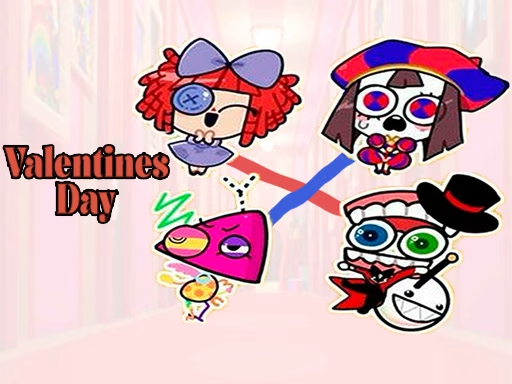
Enter the Enchanting Puzzle World of Pomni
When you first open Pomni, it feels like a simple connection game: characters waiting to link up across a grid. But as soon as you start, you realize this isn’t just about lines—it’s about strategy, timing, and a little bit of brain gymnastics. The thrill of seeing Pomni reach their friend with a perfect path is oddly satisfying, almost like watching a tiny miracle unfold on screen.
The game starts gently, with small grids and obvious routes. Your first connection feels easy, even soothing. But soon, complexity creeps in. Multiple characters, intersecting paths, and tricky obstacles make every level a puzzle worthy of attention. I remember my first level five challenge: I spent nearly ten minutes rotating options, backtracking, and smiling at my little victories. Pomni isn’t just a game—it’s an adventure in problem-solving and patience.
One of the game’s most charming aspects is its accessibility. On PC, it’s as simple as clicking a mouse to select a line. On mobile or tablet, you just tap with your finger. This intuitive design allows players of all ages to dive in without frustration. And yet, beneath the surface, the game demands real focus and strategy.
Once you’ve mastered the basics, the next challenge emerges: understanding the shortest paths. Not all connections are equal, and Pomni rewards those who think ahead.
Mastering the Art of Connection
Building on your first successful links, the next step in Pomni is mastering the shortest paths. Each level may seem straightforward at first, but subtle obstacles force you to think several moves ahead. Connecting two characters isn’t always about the direct line—it’s about strategy, timing, and efficiency.
The game introduces increasing complexity gradually. Early stages let you experiment freely, but higher levels require precision. You may need to loop around obstacles or cross paths cleverly without creating deadlocks. These challenges transform Pomni from a casual puzzle game into a satisfying exercise in mental agility.
Here’s a quick guide to paths and efficiency:
| Character Pair | Optimal Path Length | Obstacles to Avoid |
|---|---|---|
| Pomni & Buddy | 4 | Blocked squares |
| Pomni & Friend | 5 | Overlapping lines |
| Pomni & Helper | 6 | Moving barriers |
Mastering these patterns requires practice, observation, and a bit of trial and error. I found that mentally mapping connections before drawing them often prevents mistakes. Players who plan carefully not only finish faster but also enjoy a satisfying sense of accomplishment.
As you improve, you notice patterns repeating across levels. Recognizing these recurring themes makes tricky challenges more approachable. And speaking of approaches, let’s talk about strategy tips that can make Pomni feel almost effortless—once you know the tricks.
Strategic Tips for Every Level
After playing several stages, you begin to realize that Pomni isn’t about random connections—it’s about thinking like a puzzle master. Timing, prioritization, and anticipation are your best tools.
Here are some practical strategies to stay ahead:
-
Plan before connecting: Don’t rush; survey the grid first.
-
Identify the most constrained character: Connect characters with fewer available routes first.
-
Avoid path crossing early: Save intersections for last to minimize backtracking.
-
Look for shortcuts: Sometimes indirect paths are more efficient.
These simple habits dramatically reduce frustration. In fact, mastering them transforms the game from a random puzzle into a highly satisfying mental challenge. Players often report moments of “aha!” when they spot the optimal path after several failed attempts—a testament to the game’s clever design.
The beauty of Pomni is that even as difficulty ramps up, these strategies remain relevant. They create a bridge between casual enjoyment and cognitive skill-building, encouraging players to stay engaged while improving focus and problem-solving abilities.
And once you’re comfortable with basic strategies, it’s time to explore more advanced techniques that really make Pomni addictive.
Advanced Techniques: Beyond Simple Connections
Progressing beyond the introductory levels, Pomni introduces subtle complexities that challenge even experienced players. Characters may need to navigate overlapping paths, avoid barriers, and optimize multiple connections simultaneously. This is where strategic thinking and pattern recognition become essential.
For instance, some levels introduce “priority lines,” where certain paths must be completed first to unlock others. Ignoring these sequences can result in dead ends, forcing a restart. To tackle this, I developed a habit of sketching mental maps before committing any line—an approach that significantly reduces trial-and-error frustration.
Another advanced technique is leveraging symmetry. Many levels are designed with mirrored paths, allowing players to predict patterns and conserve moves. Recognizing these visual cues can turn a seemingly impossible puzzle into a straightforward solution.
Here’s a table highlighting a few advanced techniques:
| Technique | Purpose | Example Scenario |
|---|---|---|
| Priority Line | Avoid deadlocks | Pomni must reach Friend before Helper |
| Symmetry Analysis | Predict paths efficiently | Mirrored obstacles across grid |
| Indirect Routing | Avoid congestion | Longer path reduces overlaps |
With these methods in hand, even the most complex levels become manageable. But no strategy is complete without mastering timing and precision—the real heart of Pomni.
Timing and Precision: The Player’s Edge
Once advanced techniques are understood, the game’s rhythm becomes paramount. In Pomni, timing isn’t just about speed—it’s about deciding which connection to draw first and predicting the sequence of character movements. One misstep can disrupt multiple lines, forcing a restart.
Precision is crucial. On PC, precise mouse clicks reduce accidental misroutes. On mobile or tablet, careful finger taps prevent overlaps. Players often find that maintaining a calm, deliberate pace leads to more consistent success than rushing through levels.
Anticipation is equally vital. Watching the entire board before making a move allows players to foresee potential conflicts, resulting in cleaner connections. Over time, these skills naturally improve both reaction time and planning ability—a cognitive bonus hidden within addictive gameplay.
The combination of timing and precision leads to one of Pomni’s most satisfying features: streak completion. Successfully connecting multiple characters in a single sequence feels almost like orchestrating a miniature puzzle symphony.
And with these skills refined, the next logical focus is optimizing scores and efficiency across all levels.
Scoring and Efficiency: Maximizing Your Performance
Pomni rewards players not just for completing puzzles but for doing so efficiently. Each level has an implicit scoring system based on minimal moves, speed, and optimal path selection. Understanding how to maximize performance adds an additional layer of motivation and replay value.
Efficiency isn’t just a numbers game. It’s about mental clarity, planning ahead, and making every move count. Beginners might focus solely on completion, but advanced players chase perfection, striving to reduce moves and improve timing.
Here’s a simple bullet list of tips for efficiency:
-
Prioritize characters with the fewest route options first
-
Avoid unnecessary line crossings early
-
Predict the flow of subsequent moves
-
Minimize redraws by planning sequences carefully
By applying these efficiency strategies, players can turn Pomni into a game of skill rather than luck. And as performance improves, the sense of satisfaction grows, keeping players engaged for hours.
Once efficiency is mastered, the next element is creativity—finding multiple solutions and enjoying the game’s flexibility.
Creativity and Replayability
One of Pomni’s most compelling aspects is its replayability. Many puzzles have multiple solutions, allowing players to experiment with alternative routes and strategies. This flexibility encourages creativity, as you explore different ways to connect characters efficiently.
I often find myself trying unconventional paths just for fun, sometimes discovering shortcuts I hadn’t considered. These “aha” moments make the game endlessly engaging. The balance between challenge and freedom ensures that every level remains fresh, even after multiple attempts.
Additionally, the game’s increasing difficulty adds variety. New obstacles, longer grids, and multiple characters keep players adapting their strategies. This incremental challenge reinforces problem-solving skills while maintaining fun and engagement.
Replayability is enhanced by social and competitive features, which we’ll explore next, demonstrating how Pomni connects personal satisfaction with community interaction.
Social and Competitive Play
Pomni isn’t just a solitary puzzle experience. Competing with friends, sharing high scores, and tackling weekly challenges add a social layer that deepens engagement. Watching a friend solve a level faster sparks both admiration and motivation to improve.
Leaderboards create friendly rivalry, pushing players to refine strategies and optimize moves. Achievements and streaks are celebrated both personally and socially, adding incentives beyond personal satisfaction.
The combination of solitary focus and social challenge makes Pomni a game that appeals to multiple types of players. Whether you’re a calm, methodical solver or a speed-focused competitor, there’s room to enjoy and grow.
With social interaction in mind, let’s explore the cognitive benefits Pomni offers beyond fun.
Cognitive Benefits: Brain Training Through Play
Beyond entertainment, Pomni strengthens critical thinking, spatial reasoning, and pattern recognition. Planning multiple connections ahead exercises working memory, while managing intersecting paths hones problem-solving skills.
Playing regularly can improve attention span and mental flexibility, all while keeping the experience enjoyable. Parents, students, and casual gamers alike find that Pomni offers a stimulating way to exercise the mind without feeling like a chore.
The combination of challenge, strategy, and reward loops makes it an effective cognitive workout disguised as a playful puzzle.
And after all this strategy, focus, and brain training, it’s time to bring everything together with a clear call to action.
Conclusion
Pomni isn’t just a puzzle game—it’s a journey of strategy, precision, and creativity. From mastering basic connections to optimizing complex routes, players are challenged and rewarded at every turn.
Now it’s your turn: help Pomni and friends find the shortest paths, improve your reflexes, and enjoy hours of brain-teasing fun. Click, tap, rotate, and see how far your skills can take you!
For Your Social
#PomniPuzzle 🧩 #HyperCasualGame #BrainTraining #PuzzleChallenge #MobileGaming #StrategyFun #CasualGaming





